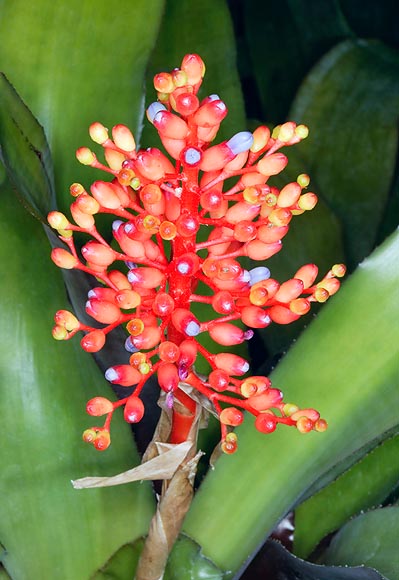Family : Bromeliaceae

Text © Pietro Puccio

English translation by Mario Beltramini

Red floral scape, coral red ovaries and sepals, blue petals © Mazza
The Aechmea miniata (Beer) Baker (1889) is native to the humid forests of eastern Brazil (Bahia).
The name of the genus comes from the Greek “aichme” = spearhead, with reference to the thorny apexes of the sepals and the floral bracts; the Latin name of the species “miniata” = red lead coloured, refers to the colour of the inflorescence.
Evergreen herbaceous plant, monocarpic (bearing fruit only one time during its existence), acaulescent, epiphytic, 30-40 cm tall, inflorescence included, it has a funnel-shaped rosette of about 40 cm of diameter of olive green leaves, slightly thorny on the margins, about 40 cm long and 4-5 cm broad, which tend to slightly widen from the base towards the extremity. The floral scape, about 30 cm long, of dark red colour, ends in a composite spike, that is, formed by more spikes which spread from a central axis, about 10 cm long, with small and red floral bracts. The single flowers are 15 mm long, with ovary and sepals of coral red colour and blue petals, tending later to become red, about 10 mm long; the fruits are bright red berries which remain long time on the plant.
Apart from by seed, it reproduces by vegetative way through the new plants coming out from axillary gemmae between the leaves and which can be detached when they have reached a dimension equal to at least a third of that of the mother plant. Very ornamental plant due to the bright colour of the inflorescence, cultivable in open air, in slightly shaded position, in the tropical and humid subtropical climates both as epiphytic and for covering the soil on very aerated, porous, draining and rich of organic substance substrata. Suitable, thanks to its reduced size, to the cultivation in pot for decorating luminous inner spaces, verandas and winter gardens, avoiding the direct sun, with temperatures over the 16°C.
The substratum must be kept slightly humid and the room humidity, in presence of dry air and high temperatures, can be, in case, increased by nebulisations, utilizing water at room temperature and not calcareous in order to avoid anti-aestethic dots on the leaves. During summer some water can be left in the central cavity formed by the rosette of leaves, renewing same frequently for avoiding that it becomes a nest of mosquito larvae, whilst in winter it is better to leave it dry in order to avoid possible rottenness. For stimulating the blossoming in the mature plants, a simple method is to hood the plant with a transparent plastic film and place at the base one or two ripe cut apples (ripe fruit, in particular the apple, develops ethylene, hormone helping the blossoming of the Bromeliaceae), for about two weeks.
Synonyms: Lamprococcus miniatus Beer (1856); Lamprococcus miniatus var. discolor Beer (1856); Aechmea fulgens var. glomerata Regel (1857); Aechmea miniata var. discolor (Beer) Beer ex Baker (1889).
→ For general notions about BROMELIACEAE please click here.
